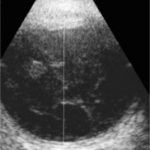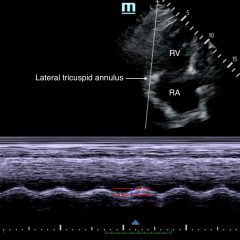Point-of-care Ultrasound Detection of Endophthalmitis
History of present illness:
A 59-year-old woman presented to the emergency department (ED) with right eye pain. She had a history of cataract surgery in the right eye three months prior. The patient was seen at an outside ED eight days prior and reportedly had normal vision, normal eye pressures, with a large corneal ulcer and hypopyon in the anterior chamber. She was given subconjunctival injections of antibiotics and discharged with antibiotic drops. She was seen by a retina specialist the next day and had no evidence of endophthalmitis.
On her second ED presentation, she had worsening right eye pain. Workup included normal intraocular pressures bilaterally and visual acuity with only light-perception in the affected eye. An ultrasound of her right eye was performed and is shown in figures 1 and 2.
Significant findings:
The patient’s ultrasound revealed an attached retina and a complex network of hyperechoic, mobile, membranous material in the posterior segment.
Discussion:
Endophthalmitis is a bacterial or fungal infection inside the vitreous and/or aqueous humors. The classic presentation is painful vision loss in a patient with recent ophthalmologic surgical intervention, an immunocompromised patient, or a septic patient. The specific bacteria or fungus causing the infection will vary depending on the reason for infection (post-surgical vs sepsis). Ultrasound findings typically include low amplitude mobile echoes, vitreous membranes, and thickening of the retina and choroid.1 Treatment for endophthalmitis includes direct, intraocular antibiotic injections by an ophthalmologist; hence, disposition for these patients would include admission for ophthalmology consultation. If there is a blood source of infection rather than a direct ocular inoculation, IV antibiotics should be initiated. Patients should also receive tetanus vaccination if tetanus status is outdated.
In this case, the patient was diagnosed with endophthalmitis of the right eye. Ophthalmology performed a tap of the posterior segment, which was sent for cultures, and gave intravitreal injections of antibiotics.
Topics:
Ultrasound, endophthalmitis, ophthalmology, ophtho, ocular, eye infection.
References:
- Kohanim S, Daniels AB, Huynh N, Eliott D, Chodosh J. Utility of ocular ultrasonography in diagnosing infectious endophthalmitis in patients with media opacities. Semin Ophthalmol.2012;25(5-6):242-245. doi: 10.3109/08820538.2012.711417
- Endogenous bacterial endophthalmitis. In: Gerstenblith A, Rabinowitz M, eds. The Willis Eye Manual: Office and Emergency Room Diagnosis and Treatment of Eye Disease. 6th Philadelphia, PA: Lippincott Williams & Wilkins; 2008:389.
- Durand ML. Clin Micobiol Infect.2013;19(3):227-234. doi: 10.1111/1469-0691.12118




